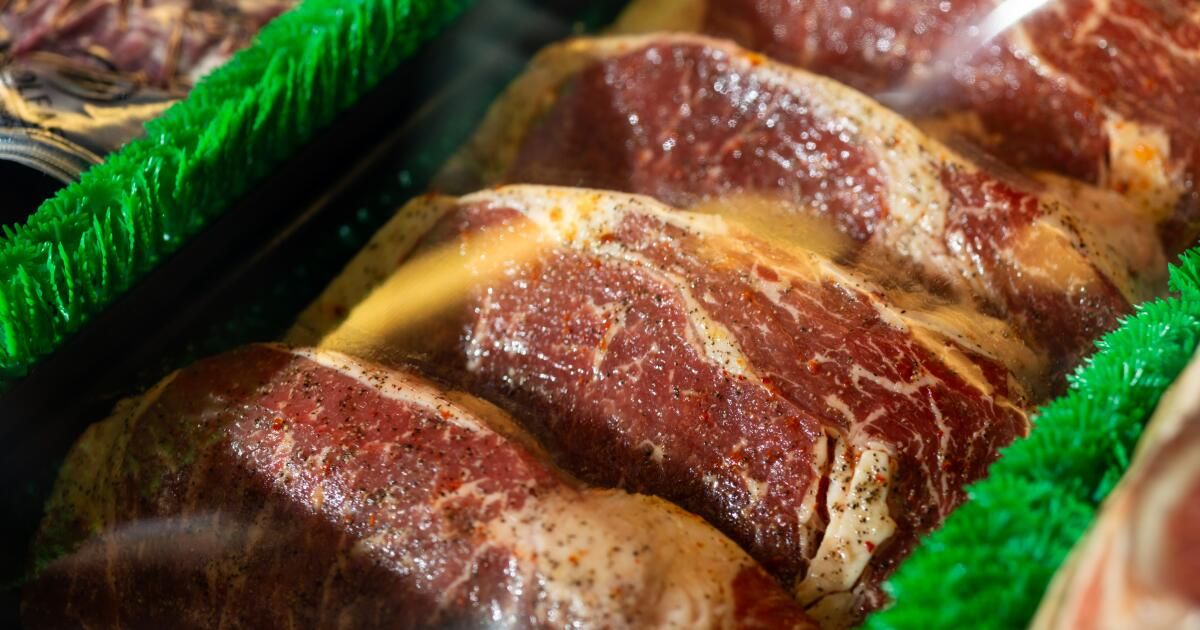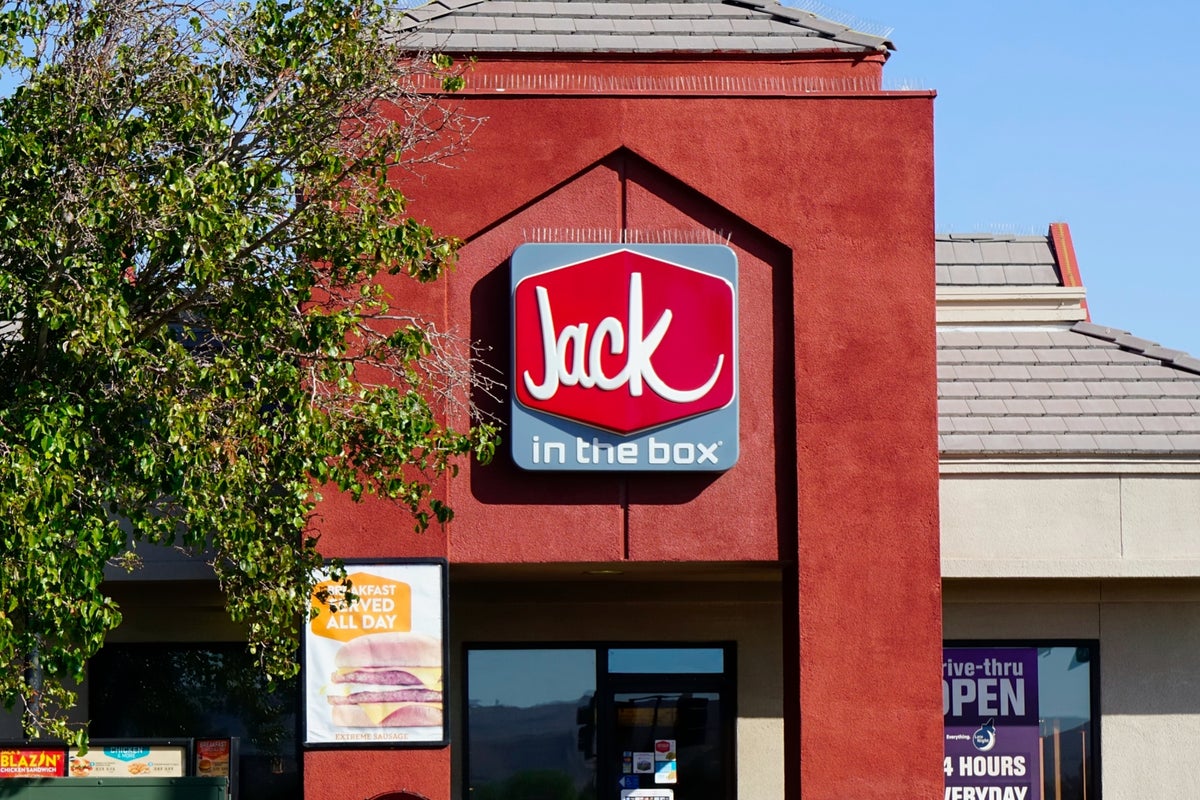One could put together a piece of cow per piece in the meat market Sevan de Glendale. Precision fillets are found in ordered ranks. The whole feet rest with the tippy tip, perpetually frozen in pre-pirueta. Brain packages live on the shelf from below, flat and frozen. This is how I imagine that my brain is seen after a few hours of displacement of Tiktok, and yet I feel obliged, because everyone is on Tiktok these days, even in my favorite meat market.
Series
Vanessa Anderson is the editions, on a mission to explore the neighborhood groceries throughout the southern California.
The social networks of Sevan Meat Market, conceived by the owner Hrach Marukyan, his son Serop and manager Norvan Simonian, tell an American Armenian history based on beef, a story of the ancient and the new, of adaptation to a world that changes rapidly. And his growing audience of now almost 60,000 Instagram followers is anxiously tune in.
In a recent video, three women with fluid hair and model -style characteristics feel close to an old well. He is sunny outside, and they wear cowboy hats. They go out to someone out of the camera, beat their eyelashes and laugh with each other. One shrugs and removes the flannel to reveal a delicate white dress. Is this generated by AI?
Before having time to reflect more, he reveals who they greet, a cowboy with a horse. One of the girls approaches him. She holds two Tomahawk fillets, sealed in plastic. She points out the fillets, lips her lip and then shows her a thumb up. It is impressed. She gets on her horse and are going away. The graph on the screen says “Sevan Meat Market.”
I first learned from Sevan Meat Market in the emerging window of the Di -pamped Diadié chef at Melody Wine Bar in Virgil Village two years ago.
Sevan “was his first plane stop from Paris,” my dining partner, private chef Gwendolyn Fogel, told me. “I had to carry it.”

The second location of the Sevan meat market, on Colorado Street in Glendale, opened in 2009 the clients of the second generation Armenian carnage love the fillets, and Instagrams publications.
Later, I would write it on my phone as a recommendation from other chefs. “Easy place for the lamb,” said a note. “Good quality, good price,” said another.
The first time I appeared, I was surprised by modernity. I expected an Armenian butcher from the old school, not an elegant black exterior with a Wagyu decal in the window. The market Instagram was equally unexpected. The 30 -second clips, sexy and completely absurd, star in the most luxurious offers of Sevan. At first glance, one could rule out the content as a low -direction and sensational click. But the social media strategy of Sevan has a mirror for popular culture more than one might think.
Sevan's Instagram is almost like a look back through the history of viral content itself. The market published its first video in 2020, which represents a Waygu box that is opening in the Instagram Boomerang format now so long awaited. In 2022, a Tomahawk span was cut as fashion in those days. At the beginning of 2024, we are served a recipe videos party, for Lula Kebab and Osso Bucco cheese sandwiches. At the end of 2024, the videos of jeans, tons of them are released. Similar to the style of a DuanjuA vertical film format popularized in China that has entered the US market with short films such as “False married to my multimillionaire CEO” and “Doctor Boss is my baby dad”, they are spicy, tedious, laughing and have seen a 992% increase in downloads between 2023 and 2024.


The first planes of the Wagyu, the left, and the roll of beef in Sevan Meat Market.
A facet of the Vaculat videos of Sevan not to ignore is the placement of the meat within a hyperpecific context. Gone are the fillets against the white funds in the weekly flyers of the past, those fillets could be anywhere. These fillets exist in a lush farm, are resistant, male and loved by beautiful women. These fillets are of high quality. They are luxurious, are they … Americans?
The beef, synonymous with American exceptionalism, has a use history of marketing tactics that play in ideals of tradition, ubiquity and family. Take the iconic Beef: is what there is for dinner campaign of the 1990s and subsequent ads such as Powerful meat landscapes As of 2008, that they do not insist so subjectly on an America built on beef.
Sevan's videos place meat as a luxury article, a wink to market standards and intelligent strategy considering The edibles are the main category Gen Z and metroIlenios are willing to waste.

Manager Norvan Simonian says he began to notice new faces in the store, an increase in sales and customers traveling from San Diego and Orange County for the fillets of Sevan.
“I am not just me; my colleagues and I put together all our ideas,” says the manager of Sevan and the star of the video Simonian in the store. When asked about his inspiration, he simply said: “Instagram and YouTube.”
The production is carried out in the owner of Sevan Hrach Marukyan's Cousin's Ranch in Springville, California, just north of Bakersfield. Then he introduces me to Hamlet Saturyan, the cousin in question. Saturyan makes the three -hour trip from Springville Ranch every week with a truck full of vine wood.
“I bring it to sell because it is good for the barbecue. It is traditional and gives the barbecue more flavor,” says Saturyan.
He tells me about Springfield. “The whole Sequoia National Park reminds me of Armenia. We do not have the giant trees, but the mountains, the rivers and the lakes.”
Simonian's instincts proved to be fruitful. As his videos accumulated views and actions, he began to notice new faces in the store, an increase in sales and customers traveling from San Diego and Orange County to have a Sevan steak.
“They even bring our flesh to different countries. Like … Armenia!” He says with a smile. “When we stop publishing videos like a week, [our customers] They are like, 'ok … we are waiting for your new videos, where are they?' “
Later, I visit the original location of Sevan Meat in East Broadway and I find that the Armenian butcher of the old school that hoped to enter the first time. Peach stone tiles on the walls resemble marble in a good steak. Rows of plastic cows figures are perched on the shelves on the butchers, which chatter in Armenian a multitude of customers, older than those of the new store, pointing to lamb chops and whole chickens.


In the first location of Sevan Meat Market on Broadway. “We do not announce at all before this,” says Serop Marukyan. “Everything was mouth to mouth.”
Both stores carry the same product, are property and operated by the same people, and their separate social media accounts are the same, for the most part. However, the new Street location has about 50,000 more followers; a new and modern car fleet in the parking lot; And a clientele that could waste Waygu tonight and would not hit the term “doomscroll”.
The old and the new Sevan are an orderly pair, and a not so subtle reminder that the small distance between first and second generation immigrants can often feel like an abyss. The old Sevan opened in 2005, the new four years later. They are three minutes by car on each other and at the same time a separate world.
“We don't announce at all before this.” Serop Marukyan says. “Everything was mouth to mouth.”
When I ask Simonian about this switch, he smiles and says: “We have to go with the new generation.”














